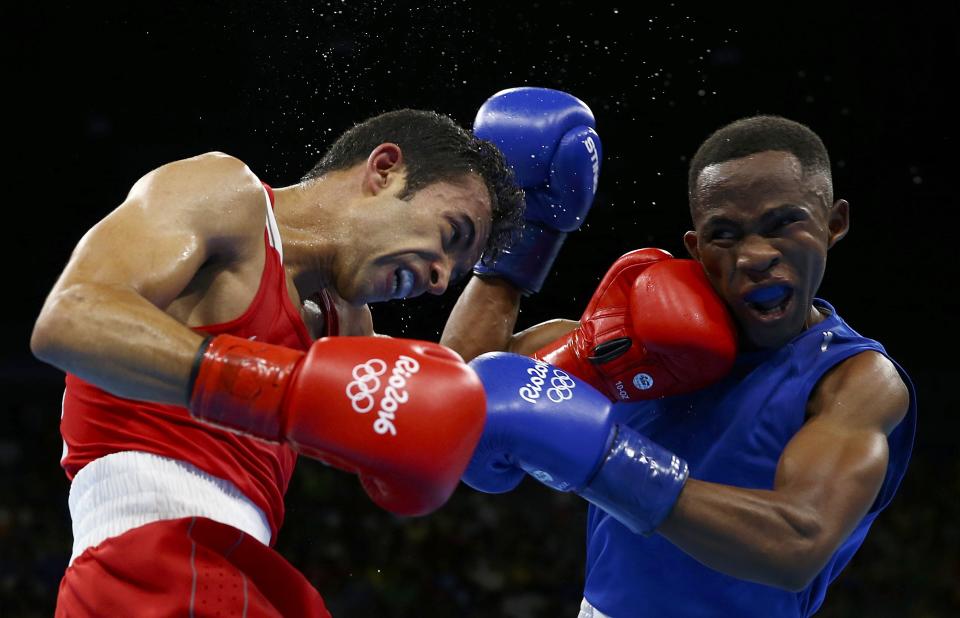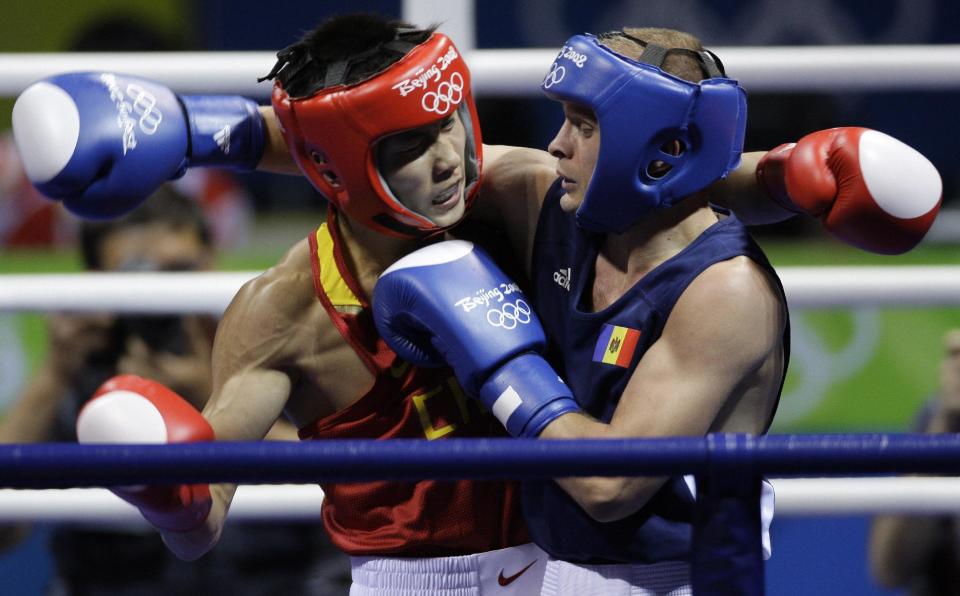Boxing debate: Does wearing headgear actually increase risk of concussion?

Medal count | Olympic schedule | Olympic news
RIO DE JANEIRO — In 2010, the International Boxing Association (AIBA), the federation that runs Olympic boxing, created a professional series it named the World Series of Boxing.
It uses the same fighters, the same doctors, the same judges and the same referees that it uses in AIBA bouts, such as the Olympics and the world championships.
Prior to June 1, 2013, there were only two differences between the groups. Boxers in AIBA events fought three-round matches and wore headguards. Boxers in World Series of Boxing bouts fought five-round matches and didn’t wear headguards.
Retired cardiac surgeon Dr. Charles Butler, a former president of USA Boxing and the chairman of AIBA’s medical commission, used the two groups to compare the rate of concussions.
The results were astounding. Butler examined 28,802 rounds, in which headguards were worn in slightly more than 14,000 and in which they were not worn in slightly under 14,000.
The results: a 43 percent reduction in concussions in bouts in which headguards weren’t worn versus bouts in which they were.
In other words, Butler’s study showed a boxer was far more likely to sustain a concussion if he wore a headguard than if he did not.
It seems paradoxical, at best, but Butler said several other studies have produced similar results.
It is the reason that boxers in the 2016 Olympics are not wearing headguards. The headguard was removed for what AIBA refers to as its elite males on June 1, 2013.
“We know that repeated concussions lead to permanent brain damage,” Butler told Yahoo Sports. “That’s been well-established.”
[Slideshow: Faces of Olympic heartbreak]
The NFL is spending tens of millions of dollars researching ways to reduce concussions, and it has researched creating helmets with all sorts of different materials to see if anything can significantly slow the rate players receive concussions.
Despite boxing’s unsavory reputation for brutality, Butler said it largely isn’t true in AIBA bouts. The International Olympic Committee did a study that he said bears that out.
“The incidence of concussion in AIBA boxing matches is extremely low,” he said. “The IOC’s injury study showed we have a lower injury rate than basketball. [AIBA boxing’s injury rate is] lower than basketball, lower than water polo, lower than rugby, lower than all these other sports.”
There has never been a death in an AIBA boxing match since it was founded in 1946. In addition, there have only been two boxers who have sustained an inter-cranial bleed in that time, one in a 2006 bout in Morocco and another on the first day of the 2008 Olympics in Beijing.
Butler said neither boxer needed surgery and both recovered normally.
Headguards first were put on boxers in 1984, largely in response to the televised death of Duk-Koo Kim, a professional boxer who died following a world lightweight title fight with popular Ray “Boom Boom” Mancini that was broadcast live on network television in the U.S.
From AIBA’s formation in 1946 until the 1984 Olympics, no headguards were worn. They were then worn from 1984 until AIBA opted to remove them on June 1, 2013.
That move wasn’t met with universal praise. Dr. Robert Cantu, a neurosurgeon and noted expert on concussion, condemned the move in an interview with The New York Times.
Cantu told the paper AIBA removed the headguards to appeal to fans who are eager to see the trauma on a boxer’s face.
“The idea that headgear prevents concussions is ludicrous to begin with,” Cantu told The Times. “It would be great if it did, but to say that taking it off will lead to fewer concussions doesn’t make sense, either.”
But Butler said other studies have supported AIBA’s research.

The 2012 International Conference on Concussion in Sport’s report was dubious about a headguard’s ability to prevent concussion.
“There is no good clinical evidence that currently available protective equipment will prevent concussion, although mouthguards have a definite role in preventing dental and or facial injury,” the study reported. “Biomechanical studies have shown a reduction in impact forces to the brain with the use of head gear and helmets, but these findings have not been translated to show a reduction in concussion incidence.”
Butler pointed to a voluminous examination of nearly 30,000 AIBA bouts from 1952 through 2011 conducted by Dr. Massimiliano Bianco of Italy and several colleagues.
The results of the study were published in 2012 in the British Journal of Sports Medicine.
Bianco wrote, “Although international amateur boxing is a well-regulated sport practiced in many countries worldwide, there are still concerns about safety and some medical organizations call for a ban on boxing. However, at this time there is no strong scientific evidence that amateur boxing is associated with serious health consequences and, in particular, with chronic traumatic brain injury. As a result, amateur boxing has been defined as a safe sport.”
Before agreeing to AIBA’s decision to remove the headguards from boxers, the IOC did a study, as well.
It did a video analysis of every punch thrown at two dramatically different AIBA events: The last world championships in which headguards were worn and the first world championships in which the decision was made to remove them.
Researchers watched for what they refer to as OSC – observable signs of concussion.
“If the boxer dropped his guard, had a stare and gaze, some observable change, they gave him a point and said, ‘All right, this is an observable sign of concussion,’ ” Butler said. “… When they finished, their study showed a 41-percent decrease in observable signs of concussion in the boxers who didn’t wear headgear.”
Butler said the primary protection a headguard affords is from cuts on the forehead. But it is rare that a boxer lands a debilitating blow to the forehead.
“How many concussions have you seen from a guy getting hit in the forehead?” Butler asked.
Instead, boxers are generally aiming for the chin, which even with a headguard is unprotected.
Studies that have examined whether a headguard reduces the force of a blow were linear – straight front to back – and didn’t mimic what happens in the ring.
A boxer will throw a punch at an angle that, when it lands on the chin, will cause the head to move from right to left or vice versa depending upon the direction from which it was thrown.
“A study that was published in the British Journal of Sports Medicine clearly shows that a headguard can clearly decrease the force of a blow, but it doesn’t decrease the incidence of concussion,” Butler said. “… When you look at what does the headguard protect, the only thing they’re measuring is linear acceleration. But what [gives you] a concussion is rotational acceleration. And a headguard gives you no protection on the chin and no protection from rotational acceleration.”
The headguard also reduces a fighter’s vision, he said, and athletes can react to an opponent’s blow up to five percent slower as a result of that.
The 2012 International Conference on Concussion in Sport noted that athletes frequently assumed riskier behavior when given more protective equipment. It refers to this practice as “risk compensation.”
In boxing, that involved fighters using their heads as weapons. They generally don’t do that without headguards because of the possibility they’d suffer a fight-ending cut.
“An important consideration in the use of protective equipment is the concept of risk compensation,” the study reported. “This is where the use of protective equipment results in behavioral change such as the adoption of more dangerous playing techniques, which can result in a paradoxical increase in injury rate.”
Women still wear headguards in the Olympics because a study hasn’t been completed on them. There is a chance in the future that women won’t wear them either.
“All I care about is the safety of the fighters,” Butler said. “That’s what this is about and nothing else: What is safest for the fighters? The evidence has led us to the direction we’ve gone.”
More Summer Olympics coverage from Yahoo Sports:

 Yahoo Sports
Yahoo Sports 
